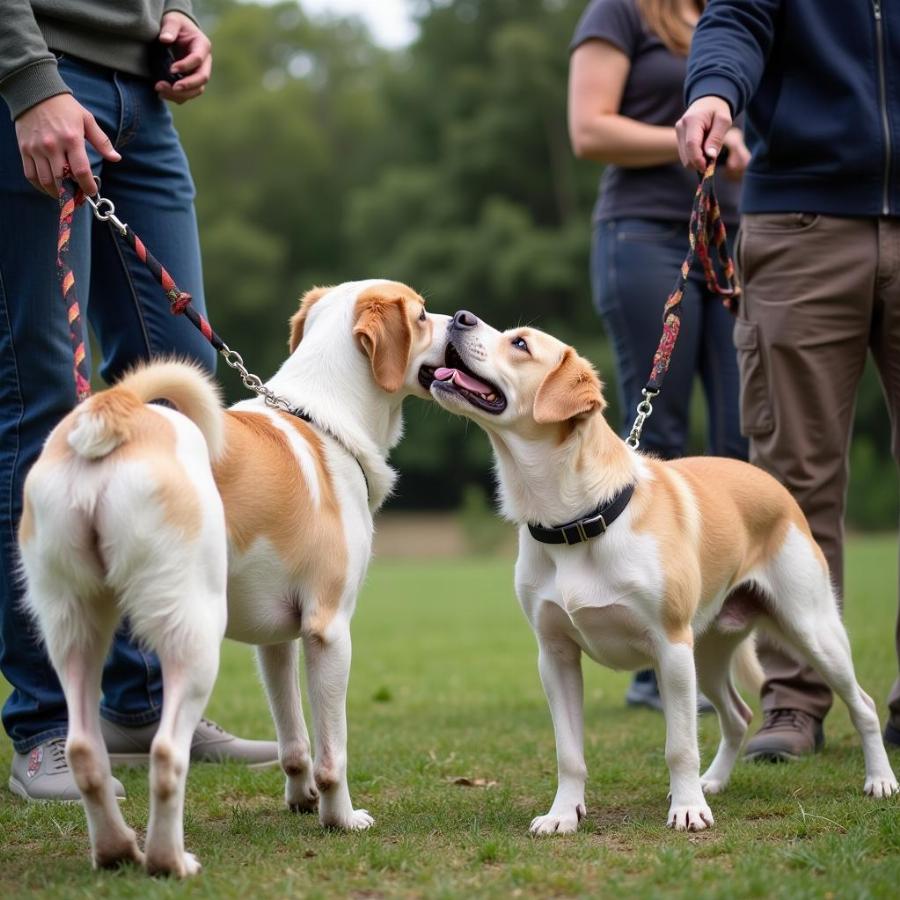Introducing two dogs can be a delicate dance. A successful introduction sets the stage for a harmonious relationship, while a rushed or poorly planned meeting can lead to fear, aggression, and long-term tension. This guide provides a step-by-step approach to how to introduce dogs to dogs safely and effectively, fostering positive first impressions and paving the way for a happy co-existence.
First Encounters: Setting the Stage for Success
When introducing dogs, the initial moments are crucial. Avoid direct face-to-face confrontations, which can be intimidating. Instead, opt for parallel walks, allowing the dogs to sniff each other from a safe distance. Keep the leashes loose to prevent any sense of restriction or anxiety. This gradual approach allows them to become acquainted with each other’s scents and body language without feeling overwhelmed.
The Importance of Neutral Territory
Choosing a neutral location is key to a smooth introduction. Avoid bringing a new dog directly into your resident dog’s territory, as this can trigger territorial instincts. A park, a friend’s yard, or even a quiet street can serve as a neutral meeting ground. This allows both dogs to approach each other on equal footing, minimizing the risk of territorial disputes.
Reading Body Language: Signs of Comfort and Stress
Pay close attention to both dogs’ body language. Loose, wiggly bodies, playful bows, and relaxed tail wags indicate positive interaction. On the other hand, stiff posture, tucked tails, whale eyes (showing the whites of their eyes), lip licking, and yawning can signal stress or discomfort. If you observe any of these signs, increase the distance between the dogs and allow them to de-stress before trying again.
Moving Towards Closer Interaction
Once the dogs seem comfortable with parallel walks, you can gradually decrease the distance between them, allowing for brief, supervised sniffs. Keep the initial interactions short and positive, ending them before either dog shows signs of stress. Reward calm behavior with praise and treats, reinforcing the positive association with the other dog.
The Sniff Test: Letting Dogs Communicate Naturally
Allowing dogs to sniff each other is a fundamental part of their communication. This helps them gather information about the other dog’s age, sex, and temperament. Interrupting this process can hinder their ability to establish a comfortable relationship. However, supervise the sniffing closely and intervene if it becomes too intense or if one dog displays dominant behavior.
 Dogs sniffing each other during introduction
Dogs sniffing each other during introduction
Supervised Play: Fostering Positive Interactions
If the initial sniffing goes well, you can allow the dogs to interact off-leash in a safe, enclosed area. Supervise their play closely, watching for any signs of aggression or excessive dominance. Keep the initial play sessions short and end them on a positive note. Positive interactions during play will help solidify a friendly bond between the dogs.
Integrating the New Dog into Your Home
Bringing a new dog home requires careful management to ensure a smooth transition for both dogs. Keep them separated initially, allowing them to acclimate to each other’s scents through the closed door. Feed them on opposite sides of the door, creating a positive association with each other’s presence. Gradually introduce them to shared spaces under close supervision, continuing to reward calm and friendly behavior.
Managing Resources: Preventing Food and Toy Aggression
Resource guarding can be a significant source of conflict between dogs. Feed them in separate areas and provide each dog with their own toys and bedding. This minimizes competition and helps prevent resource-related aggression. If you observe any signs of resource guarding, consult with a certified professional dog trainer for guidance.
Conclusion
Introducing dogs to dogs requires patience, observation, and a careful approach. By following these guidelines, you can foster a positive first impression and lay the foundation for a harmonious relationship. Remember to prioritize safety, observe body language, and reward positive interactions. A well-executed introduction can lead to years of companionship and joy for both you and your furry friends. How have you introduced your dogs to each other? Share your experiences in the comments below!
FAQ
- What if my resident dog is aggressive towards other dogs? Consult with a certified professional dog trainer or behaviorist for guidance. They can help you develop a safe and effective introduction plan.
- How long does it take for dogs to get used to each other? It varies depending on the dogs’ personalities and previous experiences. It can take anywhere from a few days to several weeks or even months.
- Can I introduce dogs of different sizes? Yes, but it’s essential to supervise their interactions closely, especially if there’s a significant size difference.
- What if one dog doesn’t seem interested in the other? Don’t force interaction. Allow them to adjust to each other’s presence at their own pace.
- Is it okay to let dogs play rough? Supervise play closely and intervene if it becomes too intense or if one dog seems overwhelmed.
- My dogs are fighting, what should I do? Separate the dogs immediately and consult with a professional dog trainer or behaviorist.
- How can I make the transition smoother for a new dog coming into my home? Provide a safe space for the new dog, introduce them gradually, and manage resources carefully.
Related Articles on Beaut Dogs
- how do you introduce dogs to each other
- how to introduce dogs
- how do you introduce dogs to cats
- how to introduce dogs to each other
Beaut Dogs: Your Ultimate Resource for Canine Companionship
Beaut Dogs is your one-stop shop for all things dog-related, offering expert advice, valuable insights, and a passionate community of dog lovers. From breed information to training tips, we provide comprehensive resources to help you navigate the wonderful world of canine companionship. For personalized guidance and support, reach out to us via Email: [email protected]. We’re here to help you build a strong and loving bond with your furry friend.